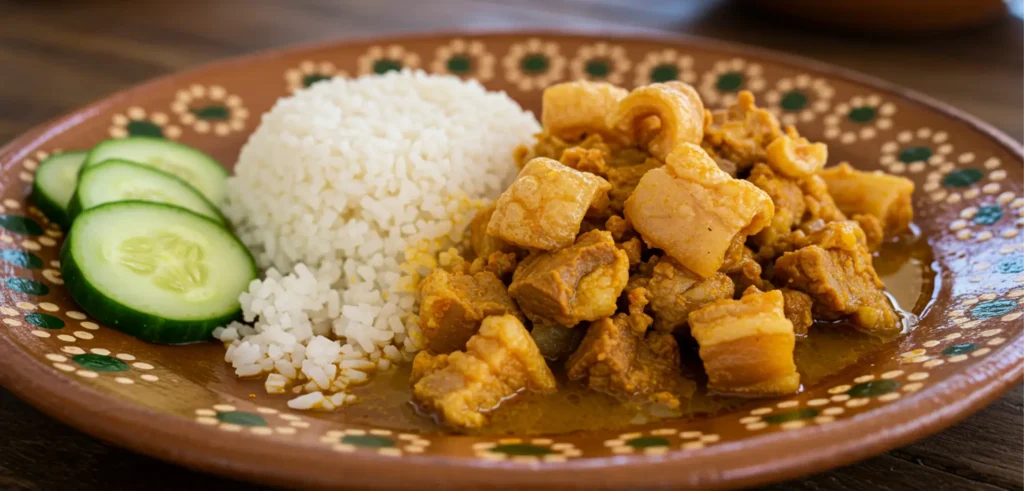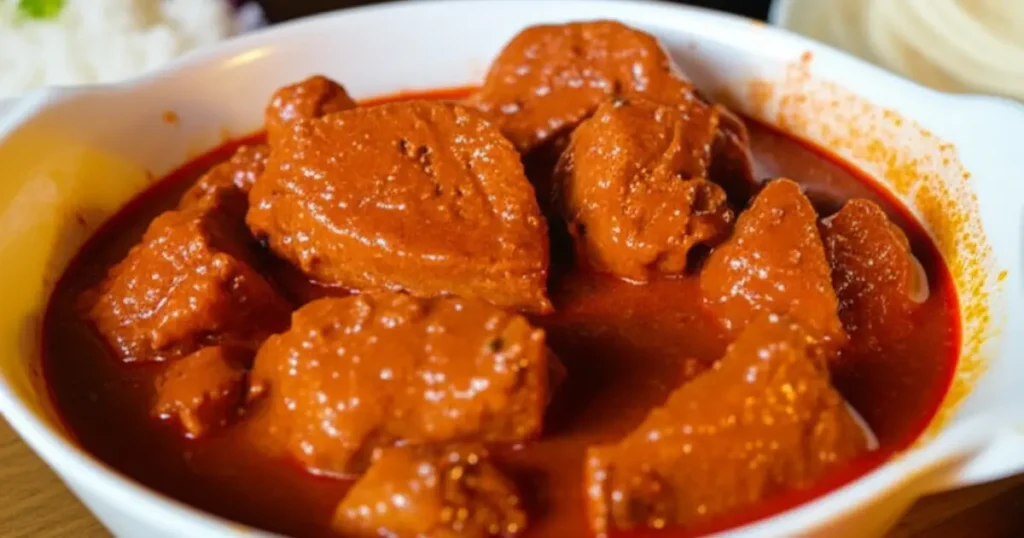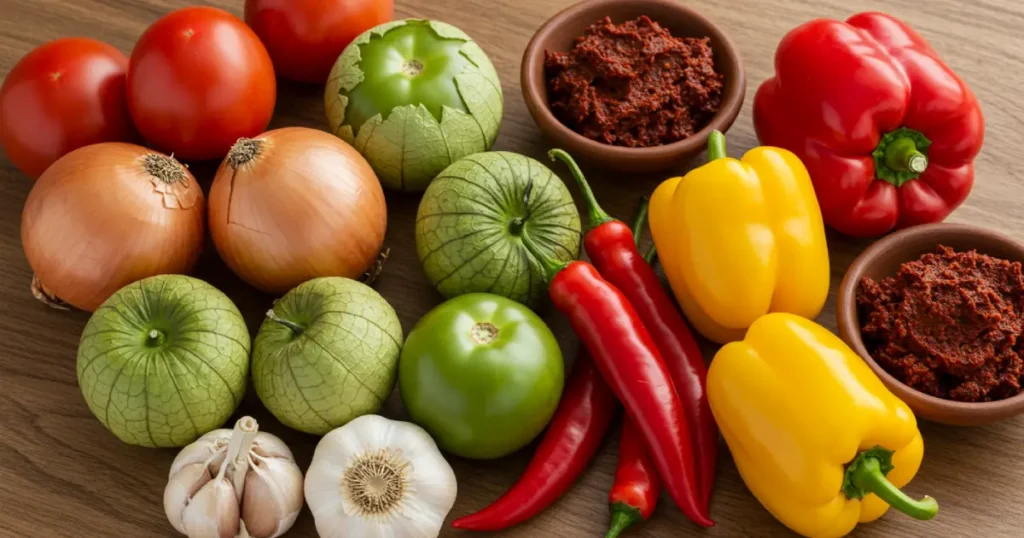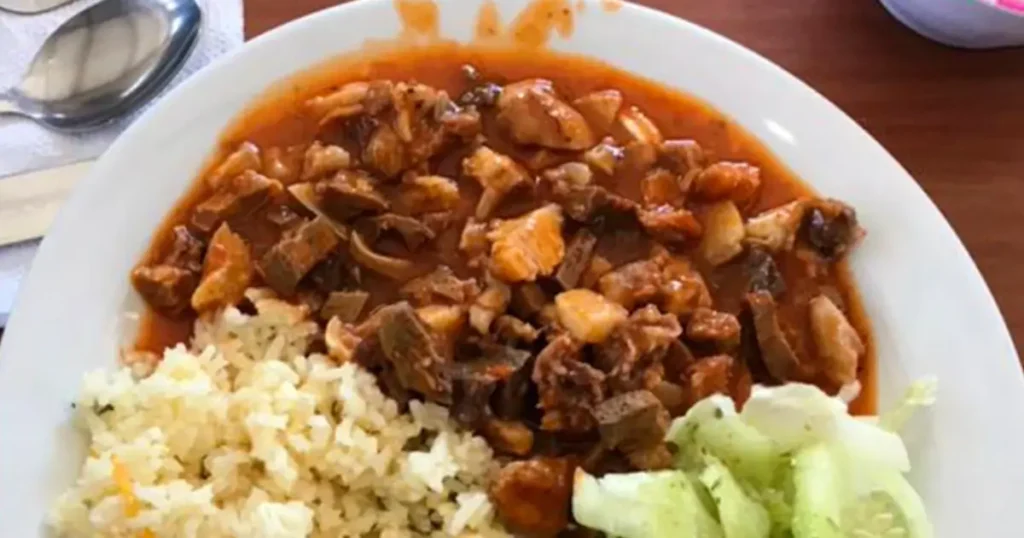Revolcado Guatemalteco: A Deep Dive into Guatemala's Beloved Pork Stew

Revolcado Guatemalteco, a name that resonates with deep flavor and rich tradition, is more than just a dish; it's a culinary emblem of Guatemala's history and cultural fusion. This hearty, complex pork stew, often described with an intensity usually reserved for beloved family recipes, captures the essence of Guatemalan cuisine – a vibrant blend of Indigenous Mayan roots and Spanish colonial influences.

While some might loosely term it a curried pork stew due to its rich spices and depth, Revolcado is uniquely Guatemalan, built upon the foundational recado – a meticulously prepared spiced sauce that is a hallmark of the nation's cooking. Join us as we explore the story, a symphony of ingredients, and the cultural significance of el Revolcado de Guatemala, a dish that truly warms the soul.
The Rich History and Origins of Revolcado Guatemalteco
The story of Revolcado is a journey back in time, reflecting the profound changes in Mesoamerican culinary landscapes. Before the arrival of the Spanish in the 16th century, Indigenous Mayan cuisine was rich with local ingredients, including native animals, vegetables, corn, beans, and a variety of chilies and spices used to create flavorful sauces and stews.
The Spanish conquistadors introduced new ingredients that would forever alter the local gastronomy. Among these, the pig was paramount. Pork quickly found its place in the Guatemalan diet, and with it came the European tradition of utilizing the entire animal. This nose-to-tail philosophy, born out of resourcefulness and respect for the animal, merged seamlessly with existing Indigenous practices.
Revolcado, as it's known today, is a direct result of this culinary syncretism. The technique of stewing meats in a spiced sauce (the recado) was already present. The Spanish contribution of pork, particularly the less prized but incredibly flavorful cuts like the head and offal, provided the protein base for what would become a cherished national dish.
Over generations, recipes were refined, regional nuances developed, and Revolcado cemented its place as a staple in Guatemalan households and a proud representative of comida típica (traditional food). The keywords revolcado Guatemalan and revolcado de guatemala speak to this deep-rooted identity.
What Exactly is in Revolcado Guatemalteco? A Breakdown of Ingredients
At its heart, Revolcado Guatemalteco is a slow-cooked stew where various parts of the pig are simmered in a rich, red recado. The beauty of the dish lies in its complex flavor profile, achieved through a careful selection and preparation of its components.

The Star of the Show: Pork – Head, Offal, and More
The defining characteristic of authentic Revolcado is its use of pork head, which provides unparalleled richness, gelatinous textures from the skin and cartilage, and tender meat from the cheeks. Beyond the head, a traditional Revolcado often includes:
- Pig Liver (Hígado de Cerdo): Adds a deep, earthy flavor and a slightly dense texture. Part of it is often cooked and chopped, while another portion might be blended into the recado itself to act as a thickener and flavor enhancer.
- Pig Intestines (Intestinos de Cerdo): When properly cleaned and cooked, intestines offer a uniquely satisfying chewiness.
- Pig Tongue (Lengua de Cerdo): A surprisingly tender and flavorful cut.
- Pig Ears (Orejas de Cerdo): Contribute a distinct cartilaginous texture.
- Pig Heart (Corazón de Cerdo): A leaner, muscular cut that adds more meaty substance.
- Posta de Cerdo (Regular Pork Meat): Some recipes also include chunks of pork shoulder or loin to increase the meatiness of the stew.
The use of these varied cuts is not just about tradition or economy; it’s about building layers of flavor and texture that make Revolcado so unique. The careful and thorough cleaning of these parts, often involving rinsing with water, lime, and vinegar, is a crucial first step in the preparation process.
The Aromatic Recado Base: The Soul of the Stew

The recado is the soul of Revolcado. This isn't a simple tomato sauce; it's a complex blend of roasted or boiled and then blended ingredients that form a thick, deeply colored, and aromatic base. Key components include:
- Tomatoes (Tomates): Ripe red tomatoes form the bulk of the sauce, providing sweetness and acidity.
- Miltomate (Tomatillos): These small, green, husk-covered fruits are essential for their characteristic tanginess, which brightens the recado and cuts through the richness of the pork.
- Onions (Cebollas): Provide a pungent, sweet aromatic base.
- Garlic (Ajo): Adds its indispensable aromatic kick.
- Bell Peppers (Chile Pimiento): Typically red bell peppers, contributing sweetness and color.
- Annatto (Achiote): This is what gives Revolcado its signature vibrant reddish-orange hue. Achiote seeds or paste impart a subtly sweet, earthy, and slightly peppery flavor. It's more for color and a unique earthy note than intense flavor.
Key Chilies and Spices: Building Complexity
While Revolcado isn't necessarily fiery hot (unless desired), chilies are crucial for their flavor rather than just heat. The selection of dried chilies, often toasted or charred before use to awaken their aromas, is key to the recado’s depth:
- Chile Guaque (Guajillo): A large, smooth-skinned dried chili with a bright red color. It offers a mild, slightly fruity, and tangy flavor with smoky undertones and very little heat. If unavailable, Guajillo is a common substitute.
- Chile Pasa (Pasilla): A long, dark, wrinkled chili (often a dried Chilaca). It contributes a rich, slightly fruity, almost raisin-like sweetness with earthy and sometimes cocoa-like notes. It also adds a deep dark color to the recado.
- Chile Zambo or other spicier chilies (Optional): Some cooks might add a touch of spicier chilies like Chile Cobanero (a smoky, hot Guatemalan specialty) or Chile de Árbol for an extra kick, but the traditional focus is on a flavorful, not overwhelmingly spicy, stew.
Other spices might include a hint of cinnamon, cloves, or allspice, depending on family tradition, adding further layers to the aromatic profile. Salt and pepper are, of course, essential.
Thickeners and Regional Variations
To achieve its characteristic stew-like consistency, Revolcado is often thickened. Traditional methods include:
- Masa Harina or Ground Tortillas: Stale tortillas or masa harina (corn flour) are sometimes blended into the recado, lending a distinct corn flavor and body.
- Bread Crumbs or Stale Bread (Miga de Pan): Another common thickener, providing a smoother texture.
- Blended Liver: As mentioned, a portion of the cooked pig liver can be blended into the sauce, adding richness and thickness.
It's worth noting that the consistency of "el revolcado de guatemala" can vary. For instance, reports suggest that in regions like Mazatenango, Revolcado might be served as a lighter, more broth-like dish with the recado added as a concentrated sauce. In contrast, versions from Guatemala City or Antigua are often described as a "puro recado," meaning a thicker, more integrated stew where the pork is thoroughly enveloped by the rich sauce.
The Art of Making Revolcado: A Step-by-Step Culinary Journey
Preparing Revolcado Guatemalteco is a labor of love, often spanning several hours, but the resulting depth of flavor is well worth the effort. While specific recipes vary from family to family and region to region, the general process follows these key stages:
Preparing the Pork: Cleaning and Boiling to Tenderness
- Thorough Cleaning: This is a non-negotiable first step, especially for the head and offal. The pork parts are meticulously cleaned, often scrubbed, and rinsed multiple times. Some cooks employ a soak in water with lime juice or vinegar to help purify the meat.
- Initial Boil: The cleaned pork pieces, particularly the head, ears, tongue, and any tougher cuts, are placed in a large pot with water, salt, and sometimes aromatics like onion, garlic, and bay leaves. This mixture is brought to a boil and then simmered for a significant period (often 2-3 hours or more) until the meat is very tender and easily falls off the bone.
- Deboning and Chopping: Once tender, the pork pieces are removed from the broth (which is often reserved). The meat is carefully separated from the bones of the head. All the chosen parts – cheek meat, tongue, ears, liver (which may be cooked separately for a shorter time to avoid overcooking), and intestines – are then chopped into bite-sized pieces.
Creating the Rich Recado: Roasting, Blending, and Simmering
- Preparing Recado Vegetables: Tomatoes, miltomates, onions, garlic, bell peppers, and chilies are typically prepared by either roasting them on a comal (a flat griddle) or charring them directly over a flame. This step is crucial as it deepens their flavors, adding smoky notes. Alternatively, some recipes call for boiling these ingredients.
- Toasting Spices and Chilies: Dried chilies (guaque, pasa) are often lightly toasted on a dry comal to enhance their aroma before being rehydrated in warm water. Seeds like achiote might also be toasted.
- Blending: The roasted/boiled vegetables, rehydrated chilies (seeds and stems removed for less heat, if preferred), achiote (paste or seeds soaked and strained), and any other chosen spices are blended until smooth. A portion of the pork cooking broth is often used as the liquid for blending. If using tortillas or bread as a thickener, they are typically soaked and blended in at this stage.
- Cooking the Recado: The blended recado is then cooked. Some recipes call for frying it in a little lard or oil, which helps to meld the flavors. It’s simmered until it thickens and darkens slightly, allowing the complex flavors to marry. This is when adjustments to seasoning (salt, pepper) are made.
Bringing it All Together: Simmering to Perfection
- Combining Pork and Recado: The chopped, cooked pork is added to the simmering recado.
- Slow Simmer: The stew is then allowed to simmer gently for at least another 30 minutes to an hour, or even longer. This slow simmering allows the pork to absorb the rich flavors of the recado and for the stew to reach its desired consistency. If it becomes too thick, a little more of the reserved pork broth can be added.
Tips from Guatemalan Kitchens for the Best Revolcado

- Patience is Key: Don't rush the cooking process, especially the initial boiling of the pork and the final simmering of the stew.
- Taste and Adjust: Constantly taste the recado and the final stew, adjusting salt and other seasonings as needed.
- Freshness of Ingredients: Using fresh, high-quality ingredients will significantly impact the final flavor.
- Don't Fear the Offal: For the most authentic flavor, embrace the traditional cuts. Each adds a unique dimension.
- Strain for Smoothness (Optional): Some cooks prefer to strain the recado after blending for an extra-smooth sauce, while others prefer a more rustic texture.
Revolcado Guatemalteco: More Than Just a Stew – Its Cultural Significance
Revolcado Guatemalteco holds a special place in the heart of Guatemalan food culture. It's not just sustenance; it’s a connection to heritage, family, and community.
- A Taste of Home: For many Guatemalans, Revolcado is comfort food, evoking memories of family meals and special gatherings. The aroma alone can transport one back to a grandmother's kitchen.
- Everyday Meal and Celebration Dish: While it can be found in local eateries ("comedores") as a hearty everyday lunch, Revolcado is also substantial enough to be served on special occasions or for family celebrations. Its preparation, often a communal effort, adds to its significance.
- Symbol of Culinary Identity: Along with dishes like Pepián and Jocón, Revolcado is a proud ambassador of Guatemalan cuisine. It showcases the nation's unique blend of ingredients and cooking techniques, reflecting a "mestizaje" (mixed heritage) that defines Guatemalan culture itself. The search term "revolcado guatemalteco" is a testament to its national importance.
- Regional Pride and Family Recipes: While the core concept of Revolcado is consistent, recipes are often fiercely guarded family secrets, passed down through generations. Slight variations in spices, chili combinations, or thickening methods contribute to regional pride and a sense of personal connection to the dish.
Experiencing Revolcado: Where to Try it and What to Expect
To truly understand Revolcado, one must taste it. Fortunately, for those traveling in Guatemala or seeking an authentic culinary experience, there are many opportunities.
Finding Authentic Revolcado in Guatemala
- Local Comedores and Markets: These bustling, no-frills eateries are often the best places to find authentic, home-style Revolcado at very reasonable prices. Look for signs advertising "comida típica." Markets, especially those with food stalls, are also excellent hunting grounds. For example, the market in Mazatenango is known for its traditional Revolcado.
- Traditional Restaurants: Many restaurants specializing in Guatemalan cuisine feature Revolcado on their menus. In Antigua, for example, establishments like El Adobe (as mentioned in the user's prompt) and La Fonda de la Calle Real are known for serving traditional dishes, and Revolcado is often a highlight. "Los 7 Caldos" is another name that comes up for good Revolcado.
- Home-Cooked Meals: If you're lucky enough to be invited into a Guatemalan home, a homemade Revolcado is an unparalleled treat, offering the most authentic and love-filled version of the dish.
How is Revolcado Served?
Revolcado is typically served hot and is a substantial meal in itself. Common accompaniments include:
- White Rice (Arroz Blanco): A simple side of fluffy white rice is perfect for soaking up the rich recado.
- Corn Tortillas: Freshly made, warm corn tortillas are indispensable for scooping up the stew or enjoying alongside.
- Tamalitos Blancos: Small, plain corn tamales sometimes accompany rich stews like Revolcado, offering a neutral counterpoint.
- Garnishes (Optional): Some might offer a sprinkle of fresh cilantro, a wedge of lime for a burst of acidity, or finely chopped raw onion for a bit of crunch and sharpness.
What to Expect: Flavor Profile and Texture
The experience of eating Revolcado is a multi-sensory one:

- Aroma: Deeply savory and aromatic, with earthy notes from the achiote and chilies, a hint of tang from the tomatoes and miltomates, and the rich scent of slow-cooked pork.
- Flavor: A complex symphony of tastes. It's savory, slightly tangy, subtly sweet from some of the chilies and vegetables, and deeply umami-rich from the pork and long cooking process. The specific flavor profile of the chilies (fruity, smoky) will shine through. It is not usually overtly spicy unless specifically made so.
- Texture: A delightful variety of textures is key to Revolcado's appeal. The recado itself is typically thick and can range from velvety smooth to slightly more rustic. The pork provides tender, shreddable meat from the head, a satisfying chew from the ears, a denser bite from the liver, and other unique textures from the tongue or intestines if included.
The Enduring Popularity of Revolcado de Guatemala
In a world of ever-changing food trends, Revolcado de Guatemala remains a steadfast favorite. Its enduring popularity stems from several factors:
- Deep, Satisfying Flavor: It’s simply a delicious and incredibly flavorful dish that satisfies a craving for something hearty and traditional.
- Cultural Connection: Eating Revolcado is an act of participating in and celebrating Guatemalan heritage.
- Nostalgia and Comfort: It’s a dish that brings comfort and evokes positive memories for many.
- Adaptability: While traditional, there’s room for slight personal or regional tweaks, keeping the dish alive and evolving within families.
The tradition of making and sharing Revolcado is passed down from one generation to the next, ensuring that this iconic stew will continue to grace Guatemalan tables for years to come, a true taste of the nation's heart and soul.

Leave a Reply